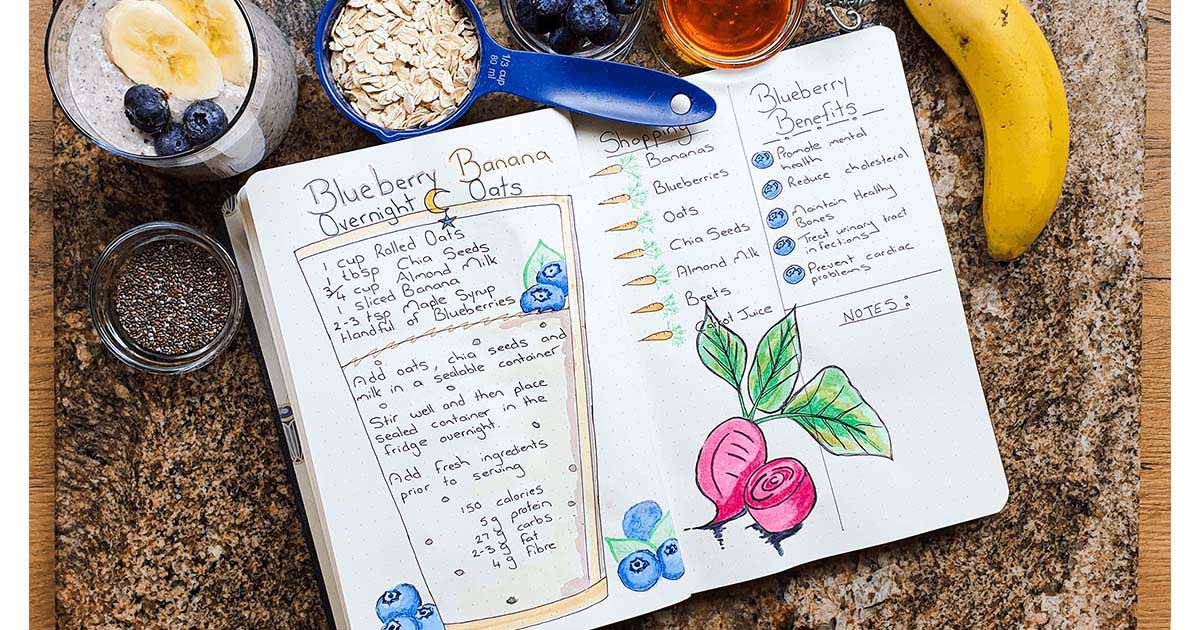8 Tips On Keeping A Health Journal

Before we start getting into anything, I have to disclose that I am in no way a health professional. This blog is simply based on my own life experiences and I hope it can help you take charge of your health!
My Health Journey
I wouldn’t say that I was ever an “unhealthy” person in the traditional sense but I have always struggled with some health issues, my main struggle throughout my whole life has been IBS (Irritable Bowel Syndrome) and the crippling headaches that came along with it – this affected my school performance, personal life and all my other goals.
After leaving school in 2017, I desperately needed a way to keep track of my health while still keeping up with an already busy schedule – this is where bullet journaling came into my life! It took some time, but eventually I found a fun, easy-to-use and highly personalised way to track my health, habits and making long-lasting change in my life.
1. Start With A Health Journal
As far as starting your health journal goes, all you will really need is a pen, pencil or any other writing supplies and, of course a journal! (make sure you love your supplies, it will make getting started that much easier). Don’t be afraid to look up some inspiration, tracking your health and fitness goals can be overwhelming . You can also have a look at our other blog wherein I explain how you can start journaling and make it a healthy habit.
2. Get To Know Yourself
This may seem like a very foreign concept or you might think that you already do know yourself, but for tracking your health and goals, you need to know exactly where you are at and where you want to be goal-wise. You need to decide exactly what I want to gain by keeping a health journal. Everyone’s goals will be different, mine for instance, was to track which foods triggered my IBS, tracking headache patterns, tracking my exercise and developing overall healthier habits.
3. Setting Your Health And Fitness Goals
Once you know what you want to achieve, it’s time to set it in stone…or paper at least. Start by dividing your health and fitness goals into three categories; body, food and mind. Your body goals might be to start stretching or exercising a couple of times a week; food goals could be to eat more fruits and veggies while mind goals could be to start meditating. (whatever you want to achieve)
Remember to make your goals achievable, there is no use in saying that you will be weight lifting for 5 days a week whole year round, goals like that are not practical and you will be setting yourself up for failure – avoid this mistake by making goals smaller and giving yourself room to adjust and grow new habits sustainably, for example, for the next week “I will be eating two portions of vegetables every night”
After spending your whole life doing something a certain way, you can’t expect to break that pattern over night – it is going to take effort, self-dicipline and sustainable goal setting!
Also remember not to get lost in trends and fads, for a very long time I struggled with comparing myself to others and conforming to society’s definition of being healthy, it was never worth it – always stay in touch with yourself and what you need!
4. Create An Exercise Log
There is something extremely satisfying and rewarding about finishing a workout and putting it down on paper – it feels like a pat on the back! Exercise logs will keep you motivated to step up and reach your goals. Fitness and exercise goals can be logged in a variety of ways. They can range from a calendar, logging all your daily activities, or a very precise and specific exercise regime. Its all up to you!
I used the calendar method, because walking up and down my home, playing with my pets and running errands stills counts as being active! You are not just exercising when you step into a gym to lift weights.
A daily tracker is also a fun way of doing it.
5. Keeping A Food Diary
This part was the most interesting for me and in keeping a food diary I realised where most of my bad habits were – right there in my fridge – processed meats, sugary drinks, GMO filled sauces and fatty fast foods – it was a complete IBS bomb! I was doing the exact opposite of what my doctors recommened by not reading food labels and only trusted that they said it was “low sugar” or “low fat”. After going on a fridge cleaning rampage, I focussed on adopting a new mindset regarding food; whole food is good food.
Your food goals might be to eat in order to loose weight or just to cultivate new healthier eating habits. No matter what is is, start by writing down everything you eat in a daily food intake tracker, be very specific, and also write down the amounts – in doing this you can easily count calories, pin-point bad eating habits and introduce new foods.
To get even more specific, you can track your macro and micro nutrients or lay out an eating plan that you would like to follow.
6. Create A Monthly Health Challenge
Don’t you just love proving your self-doubt wrong? I sure do! Setting a monthly challenge helps one stay motivated. It can be something simple like wanting to be able to run 5km at the end of the month. By writing down your monthly goal and daily steps, you are sure to achieve it with ease!
My very first goal was to be able to meditate without drifting of to sleep, I took some time doing research about meditating and meditated using different techniques for 30 days until I found the method that works best for me!
7. Monitoring A Chronic Condition Or Weight Loss
Like I said in the beginning, monitoring my IBS was one of the main reasons I started a health journal. It’s extremely important to track chronic conditions, whether it be diabetes, IBS, insomnia, headaches, heartburn or back pains, or even weight loss.
Since my condition affects my digestive system, my condition tracker focused mainly on my food intake and how it made me feel, I also tracked my water intake, medication, sleep patterns and headaches. By tracking everything, I was able look back and find triggers that caused IBS flare-ups and correlations between certain foods and the severity of my headaches – by changing out these foods I saw a significant change in my sleeping patterns, energy levels and even my skin’s condition!
Monitoring your condition will help you notice changes and even pin point problems you didn’t even know you had – and most important, it help you know when things are getting worse and when to see a doctor.
8. Keep A Habit Tracker
We all have some bad habits that we need to kick to the curb, but like me, you probably don’t even know what they are. In the very first few months of my habit tracking, I saw just how many unhealthy choices I made, like going a whole day without water or eating a bowl of cereal instead of cooking a healthy dinner. I stared using the tracker to introduce healthier habits, like cutting my sugar intake, fruits and veggies, my medication and exercise, I even started using the tracker for things like mindfulness, gratitude and stress levels.
It’s great to look back on a habit tracker to see how your habits are improving, it is very fulfilling, especially after doubting yourself for so long and believing that you are unable to live a healthy life.
You First
Putting yourself first might sound selfish or like a cliche, but when it comes to your health, you are second to none. It took me the longest time to really love and appreciate my body, mind and soul and in today’s image-obsessed world the struggle of self-love has never been harder – so I implore you to invest some time in yourself everyday to track your health and be the best you that you can be!








Leave a comment